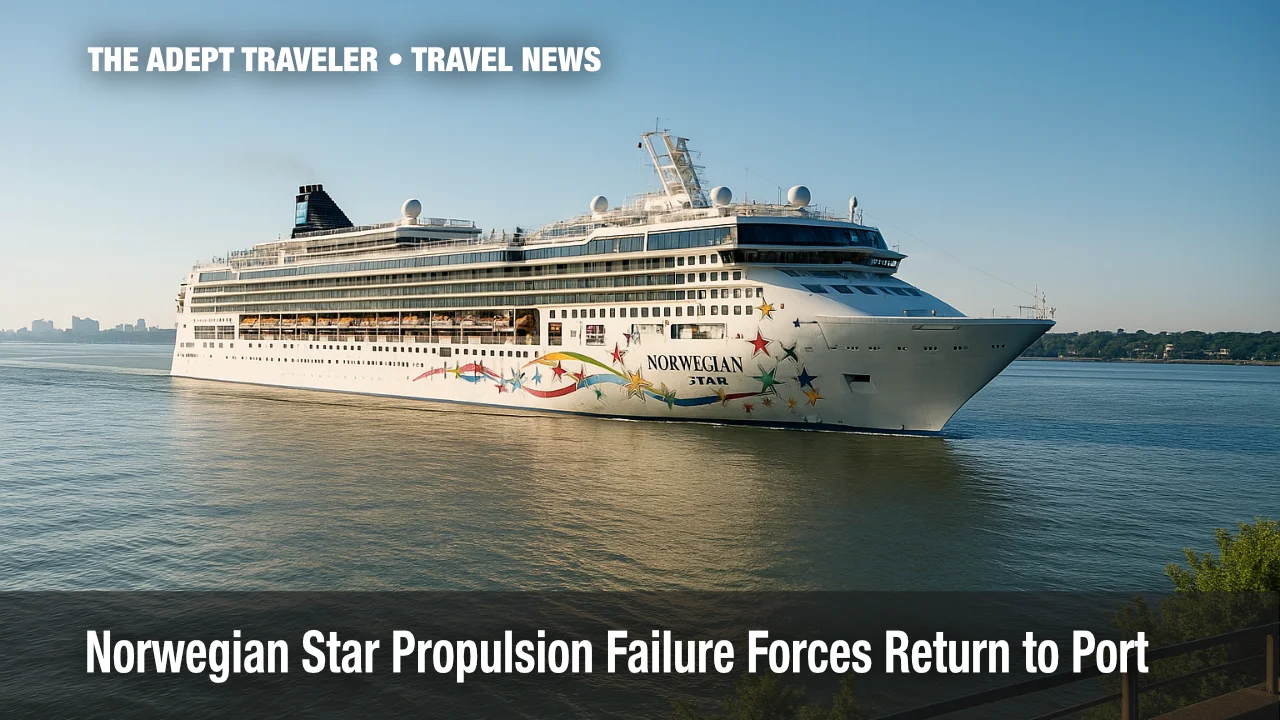Norwegian Star Propulsion Failure Forces Return to New York

Norwegian Cruise Line's Norwegian Star suffered a brief but dramatic propulsion failure shortly after leaving Manhattan Cruise Terminal on July 12, forcing the captain to anchor mid-Hudson River and accept tug assistance back to Pier 88. Power, air-conditioning, and running water flickered off and on for several hours as crew diagnosed the fault. Repairs were completed beside the pier, and the United States Coast Guard cleared the 2,348-passenger ship to sail again at 12:30 a.m. on July 13. The itinerary-14 nights from New York to Reykjavik with Canadian and Greenlandic calls-remains unchanged.
Key Points
- Why it matters: mechanical reliability directly affects traveler confidence.
- Propulsion failure left the ship without power, AC, or water for hours.
- Two tugboats guided the vessel back to Manhattan for shoreside inspection.
- Repairs completed the same evening; Coast Guard cleared departure at 12:30 a.m.
- Norwegian Cruise Line says the cruise will keep every scheduled port call.
Snapshot
The incident unfolded less than two hours after departure. With engines down, Norwegian Star drifted in the river heat-upper-80 °F-while engineering teams worked below deck. Shore observers reported the ship stationary off Hell's Kitchen, flanked by tugboats. Once alongside Pier 88, technicians restarted critical hotel services and isolated the faulty component. By early Sunday, the vessel was steaming east at 19 knots, allowing a full sea day before Monday's call at Halifax, Nova Scotia. There are no reports of injury or fire.
Background
Mechanical hiccups are not new to the 2001-built Dawn-class ship. Norwegian Star relies on twin ABB Azipod units-an electric propulsion system that has failed repeatedly over the years. Norwegian Cruise Line won a $159 million judgment against the manufacturer in 2022 over chronic Azipod defects, though the company has not confirmed whether the same hardware caused this weekend's blackout. Past incidents include slowed crossings in 2017 and an unscheduled dry-dock in 2020. Despite those events, the ship routinely operates remote itineraries, including seasonal voyages to Antarctica and the North Atlantic.
Latest Developments
The line insists the schedule will proceed without alteration. Below is a concise chronology and outlook.
Timeline of the Incident
- 4:00 p.m., Jul 12 - Departure from Manhattan Cruise Terminal.
- ~5:45 p.m. - Loss of propulsion; ship anchors mid-Hudson River.
- 6:30 p.m. - Tugboats dispatched; intermittent hotel-service outages reported.
- 8:15 p.m. - Ship alongside Pier 88; inspections begin.
- 12:30 a.m., Jul 13 - Coast Guard clearance; ship departs New York.
Passenger Experience On Board
Cabins warmed quickly once air-conditioning failed, but crew distributed bottled water and opened outdoor decks to catch breezes. Dining venues stayed closed until backup generators stabilized galley refrigeration. Social-media posts praised staff communication yet voiced concern over repeated "engine alarms."
Next Steps & Itinerary Outlook
Operational teams will monitor the propulsion plant during the transit to Halifax, Sydney, Prince Edward Island, Nuuk, Paamiut, and three Icelandic ports. Norwegian Cruise Line states additional engineers embarked overnight and spare parts are stocked on board to avoid further disruption.
Analysis
For travelers, the episode underscores two planning realities. First, propulsion failures, while rare, can occur even on large-fleet brands such as Norwegian Cruise Line. Comprehensive cruise itinerary disruption insurance remains a wise hedge: policies that reimburse missed ports or delayed flights cost far less than last-minute air changes from Iceland. Second, mechanical history should factor into cabin selection. Older ships like Norwegian Star often carry extra redundant equipment but may also possess legacy systems prone to wear. Consulting a travel advisor who tracks vessel maintenance records helps guests balance risk, routing, and fare.
Final Thoughts
Saturday's scare ended without cancellation, and most guests will remember only an extended Manhattan skyline view. Even so, the incident revives scrutiny of Norwegian Star propulsion failure risks ahead of future transatlantic seasons.
